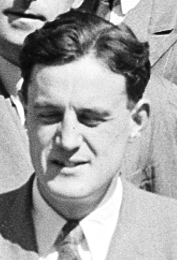Robert Hanbury Brown facts for kids
Quick facts for kids
Robert Hanbury Brown
|
|
|---|---|

Hanbury Brown at the International Union of Radio Science conference, Sydney 1952
|
|
| Born | 31 August 1916 Aruvankadu, British India
|
| Died | 16 January 2002 (aged 85) |
| Nationality | British |
| Alma mater | University of London |
| Spouse(s) | Heather Hilda Chesterman |
| Awards | ANZAAS Medal (1987) |
| Scientific career | |
| Fields | Astrophysics |
Robert Hanbury Brown (born August 31, 1916 – died January 16, 2002) was a British astronomer and physicist. He was born in Aruvankadu, India. He helped create radar, which uses radio waves to find objects. Later, he did important work in radio astronomy, studying objects in space using radio waves.
With another scientist, Richard Q. Twiss, he discovered the Hanbury Brown and Twiss effect. This led to new tools called intensity interferometers. These tools help measure the size of stars. Hanbury Brown also designed a big telescope called the Narrabri Stellar Intensity Interferometer. He received many awards for his amazing work.
Contents
Early Life and Education
Robert Hanbury Brown was born in 1916 in Aruvankadu, India. His father was an army officer. When he was 8, he moved to England for school. He went to Cottesmore School in Hove. There, he mostly studied subjects like history and literature, not science.
At 14, in 1930, he went to Tonbridge School. After two years, he moved to Brighton Technical College. He had planned to study old languages, but people around him influenced him. His grandfather, Sir Robert Hanbury Brown, was an early radio pioneer. His legal guardian was also a radio engineer. At Brighton Technical College, he studied electrical engineering. He earned his degree from the University of London when he was 19. He also published his first science paper around this time.
Career in Science
Hanbury Brown first planned to get a Ph.D. at Imperial College, London. But a scientist named Henry Tizard asked him to work on radar. From 1936 to 1942, he worked at the Telecommunications Research Establishment. He helped develop the Chain Home radar system.
After that, he spent three years in Washington, D.C.. He worked with the U.S. Naval Research Laboratory. There, he helped create the Rebecca/Eureka transponding radar. He and John William Sutton Pringle first invented this system.
In 1947, he joined a company started by Sir Robert Watson-Watt, who is known as the "father of radar." This company turned wartime inventions into peaceful technologies. Hanbury Brown worked there as an engineer. When the company moved to Canada, he decided to join Bernard Lovell's radio astronomy group. This was at the Victoria University of Manchester in 1949. He started working on his Ph.D. there.
Discovering Radio Waves from Space
At the University of Manchester, Hanbury Brown worked with Cyril Hazard. They changed a large radio telescope that was used to study cosmic rays. They made it into a full radio telescope. Using this telescope, they found that radio waves were coming from the Andromeda Galaxy. This was a big discovery. It showed that radio waves came from beyond our own galaxy. Later, after the Lovell Telescope was built, Hanbury Brown was part of the team that used it to discover quasars. Quasars are very bright objects in the distant universe.
Pioneering Interferometry
Hanbury Brown is most famous for his work on interferometry. This is a technique that combines signals from multiple telescopes. He developed the Hanbury Brown and Twiss effect. This led to the creation of intensity interferometers. Some scientists thought his ideas went against the laws of physics. But Hanbury Brown and Twiss proved their theory was correct through many observations.
In 1962, Hanbury Brown moved to Australia. He worked at the University of Sydney. There, he built his next interferometer. It was called the Narrabri Stellar Intensity Interferometer. He built it in a sheep field outside Narrabri in New South Wales. It had two large telescopes, each 23 feet wide.
Using this new tool, Hanbury Brown measured the sizes of 32 stars. This was the first time scientists had accurately measured the diameters of so many stars. This helped create a temperature scale for hot stars. He had planned to stay in Australia for only two years, but he ended up staying for 27 years. In 1986, he received the Companion of the Order of Australia for his important work.
Personal Life
Robert Hanbury Brown married Heather Hilda Chesterman in 1952. They had one daughter and two sons (twins).
He passed away in Andover, Hampshire on January 16, 2002.
Honours and Awards
Hanbury Brown received many awards for his scientific contributions:
- 1959: Fernand Holweck Medal and Prize
- 1960: Elected a Fellow of the Royal Society of London
- 1968: Eddington Medal (with Richard Q. Twiss)
- 1971: Hughes Medal from the Royal Society
- 1972: Thomas Ranken Lyle Medal
- 1982: President of the International Astronomical Union (until 1985)
- 1982: Albert A. Michelson Medal (with Richard Q. Twiss)
- 1982: Matthew Flinders Medal and Lecture
- 1986: Appointed Companion of the Order of Australia

